Siemens 2015 User Manual
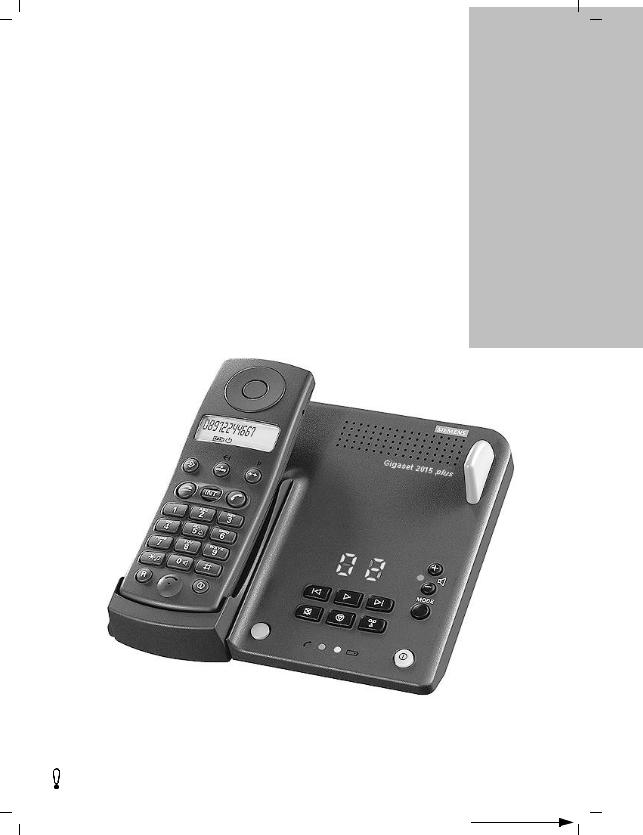
29.10.99 |
bk_front.fm5 |
Gigaset 2015 plus, GBR: A30852-X1105-B401-1-7619 |
s
The cordless digital DECT telephone system for up to 6 handsets
with integrated answering machine
Gigaset 2015 plus
Operating instructions
Please read these operating instructions carefully (including the safety notes) before starting up the equipment!
ACHTUNG! Schnittkante ggf. auf Titelseite U1 nach außen versetzen wg. Falz-Ausklappseite

29.10.99 |
kap00.fm5 |
Gigaset 2015 plus, GBR: A30852-X1105-B401-1-7619 |
Gigaset® 2015 plus
Your signpost to the system:
Your first telephone call
Using the answering machine
Using several handsets
Using several base stations
Quick-reference guide
II
Putting the device into operation
( page 1). Making a call ( page 7).
Basic answering machine settings ( page 21).
Recording announcements and advisory messages ( page 45).
Listening to recorded messages ( page 48).
Logging on new handsets at the base station ( page 57).
Making internal telephone calls ( page 10).
Internal consultation during external calls and internal transfer of external calls ( page 12).
Logging on handsets at new base station ( page 57).
Activating base station display and optimal setting of station search
( page 62).
Quick-reference guide ( page 75) for remote operation to cut out (see back page).
U2
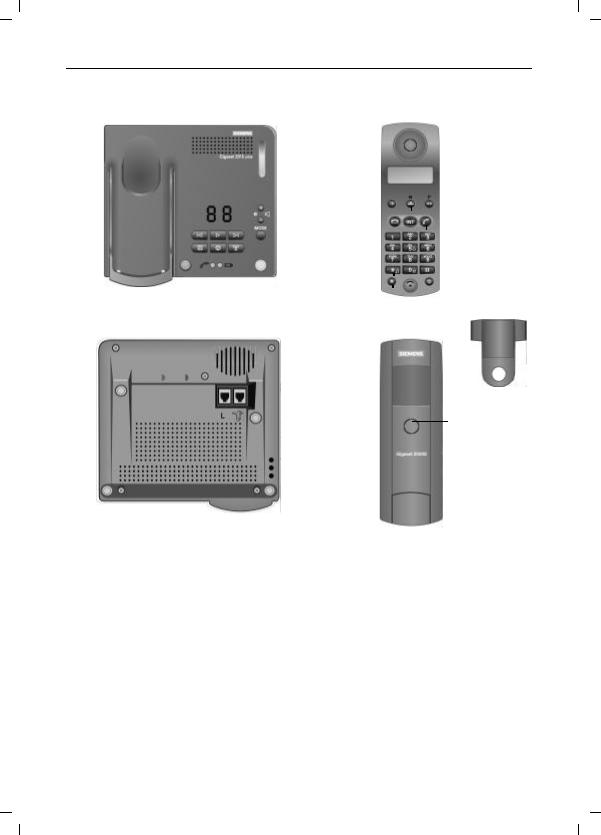
29.10.99 |
kap00.fm5 |
Gigaset 2015 plus, GBR: A30852-X1105-B401-1-7619 |
Overview: Gigaset 2015 plus
|
|
|
|
|
|
|
|
|
|
|
|
|
|
|
|
|
|
|
|
|
|
|
|
|
18 |
|
|
|
|
|
|
|
|
|
|
|
|
|
|
|
|
|
|
|
|
|
|
|
|
|
|
|
|
|
|
|
|
|
|
|
|
|
|
|
|
|
|
|
|
|
|
|
|
|
|
|
|
|
|
|
|
|
|||
|
|
|
|
|
|
|
|
|
|
|
|
|
|
|
|
|
|
|
|
|
|
|
5 |
19 |
|
|
|
|
|
|
|
|
|
|
|
|
|
|
|
|
|
|
|
|
|
|
|
|
|
|
|
|
|
|
|
|
|
|
|
|
|
|
|
|
|
|
|
|
|
|
|
|
|
|
|
|
|
|
|
|
|||||
1 |
|
|
|
|
|
|
|
|
|
|
|
|
|
|
|
|
|
|
|
|
|
|
20 |
|
|
|
|
|
|
|
|
|
|
|
|
|
|
|
27 |
|
||
|
|
|
|
|
|
|
|
|
|
|
|
|
|
|
|
|
|
|
|
|
6 |
21 |
|
|
|
|
|
|
|
|
|
|
|
|
|
|
|
|
||||
|
|
|
|
|
|
|
|
|
|
|
|
|
|
|
|
|
|
|
|
|
|
|
|
|
|
|
|
|
|
|
|
28 |
|
|||||||||
|
|
|
|
|
|
|
|
|
|
|
|
|
|
|
|
|
|
|
|
|
||||||||||||||||||||||
2 |
|
|
|
|
|
|
|
|
|
|
|
|
|
|
|
|
|
|
7 |
22 |
|
|
|
|
|
|
|
|
|
|
|
|
|
|
29 |
|
||||||
3 |
|
|
|
|
|
|
|
|
|
|
|
|
|
|
|
|
|
|
|
|
|
|
8 |
|
|
|
|
|
|
|
|
|
|
|
|
|
|
|
|
|
|
|
4 |
|
|
|
|
|
|
|
|
|
|
|
9 |
23 |
|
|
|
|
|
|
|
|
|
|
|
|
|
|
|
|
|
||||||||||||
|
|
|
|
|
|
|
|
|
|
|
|
|
|
|
|
|
|
|
|
|
|
|
|
|
|
|
|
|||||||||||||||
|
|
|
|
|
|
|
|
|
|
|
|
|
|
|
|
|
|
|
||||||||||||||||||||||||
|
|
|
|
|
|
|
|
|
|
|
|
|
|
|
|
|
10 |
24 |
|
|
|
|
|
|
|
|
|
|
|
|
|
|
30 |
|
||||||||
|
|
|
|
|
|
|
|
|
|
|
|
|
|
|
|
|
|
|
|
|
|
|
|
|
||||||||||||||||||
|
|
|
|
|
|
|
|
|
|
|
|
|
|
|
|
|
|
|
|
|
|
|
|
11 |
|
|
|
|
|
|
|
|
|
|
|
|
|
31 |
|
|||
|
|
|
|
|
|
|
|
|
|
|
|
|
|
|
|
|
|
|
|
|
|
|
|
25 |
|
|
|
|
|
|
|
|
|
|||||||||
|
|
|
|
|
|
|
|
|
|
|
|
|
|
|
|
|
|
|
|
|
|
|
|
|
|
|
|
|
|
|||||||||||||
|
|
|
|
|
|
|
|
14 |
|
|
|
|
|
|
|
|
|
|
|
|
|
|
26 |
|
|
|
|
|
34 |
|||||||||||||
12 |
13 |
15 |
|
|
|
|
|
|
|
|
|
|
|
|
|
|
|
|
|
|
|
|
|
|
|
|
|
|
|
|
|
|||||||||||
|
|
|
|
|
|
|
|
|
|
|
|
|
|
|
|
|
|
|
|
|
|
|
|
|
|
|
|
|
|
|
|
|
|
|
|
|
|
|
|
|
|
|
16 |
|
|
|
17 |
|
|
32
|
|
|
|
|
33 |
|
|
|
|
||
1 |
Handset rest/charger unit |
18 |
Receiver inset |
||
2 |
Message playback |
19 |
Display |
||
3 |
Backward scrolling through messages |
20 |
Storage key |
||
4 |
Message deletion |
21 |
Speed dialling key |
||
5 |
LED indicator: number of messages |
22 |
On-hook key |
||
6 |
Increasing loudspeaker volume |
23 |
Dialling keypad |
||
7 |
Lowering loudspeaker volume |
24 |
Star key |
||
8 |
Selecting answering machine mode |
25 |
Signal key |
||
9 |
Forward scrolling through messages |
26 |
Microphone |
||
10 |
Switching answering machine on/off |
27 |
Redial key |
||
11 |
Recording announcements/memos |
28 |
Internal key |
||
12 |
Paging key (broadcast for logged-on handsets) |
29 |
Off-hook key |
||
13 |
LED for “dialup line busy” display |
30 |
Square key |
||
14 |
Stop key for answering machine |
31 |
On/off/protect key |
||
15 |
LED for “charge batteries” display |
32 |
Tone ringing loudspeaker |
||
16 |
Socket for telephone connecting cable |
33 |
Battery compartment |
||
17 |
Socket for power connecting cable |
34 |
Carrying clip |
||
III
U3

29.10.99 |
kap00.fm5 |
Gigaset 2015 plus, GBR: A30852-X1105-B401-1-7619 |
Overview: keys
Keys on the base station
Green paging key for broadcast calls to all logged-on
?handsets
Switching the answering machine on/off
h
Skipping backwards during message playback on
È
answering machine
Listening to messages on the answering machine
É
Skipping forwards during message playback on
Ê
answering machine
MODEy Selecting the operating mode of the answering machine
Recording announcements/advisory message and
Í
personal memos for the answering machine
Deleting announcements/advisory message and
Ë
messages (answering machine)
Stop key for aborting or terminating
Ì
+Increasing the loudspeaker volume
-Decreasing the loudspeaker volume
Keys on the Gigaset 1000S handset
Storage key for initiating and terminating procedures in
|
|
B which data is stored |
|
|
Speed dialling key for administering and selecting speed |
|
|
Q dialling numbers. Delete key for correcting telephone |
|
|
numbers (en-bloc dialling, speed dialling and last number |
|
|
redial. |
|
|
Redial key |
|
|
O |
|
|
For settings, this key is used for temporarily storing and |
|
|
initiating a new procedure. |
1to |
0, *and |
Dialling keys for telephone numbers and input keys for |
# procedures |
||
|
|
Signalling key (flash) for transmitting a signal tone to the |
|
|
R public switched telephone network or to PBXs |
|
|
Internal key for dialling internal numbers or for remote |
|
|
I operation of the answering machine and activating the |
|
|
“open listening” function |
|
|
Key for switching the handset on/off or for activating the |
|
|
h protect mode |
|
|
Off-hook key for setting up external connections. |
|
|
c |
|
|
On-hook key for terminating calls. |
|
|
a For settings, this key is used to cancel a procedure. |
IV
U4

29.10.99 |
kap00.fm5 |
Gigaset 2015 plus, GBR: A30852-X1105-B401-1-7619 |
Overview: displays
uPzAHn-8888888cc
Af Nb EFG H
Digits or characters which have been entered are indicated on the top line of the display. The bottom line contains symbols relating to the current operating state.
Digits and characters on top line of handset display
u Signal keyR pressed.
PManual dialling pause inserted (operation in conjunction with a PBX).
z |
Memory is empty. |
|
Trunk code dialled (operation in conjunction with a PBX). |
||
A |
||
|
HMain trunk code dialled (operation in conjunction with a PBX).
n Star key *pressed
-Square key #pressed.
c |
Volume of incoming speech, level 2. |
cc |
Volume of incoming speech, level 3 |
zzzz |
Protect mode |
|
Symbols on bottom line of handset display
A |
Indicates that the handset is in storage mode. |
Numbers cannot be dialled in this mode. |
j Battery symbol. Flashes for approximately 5-10 minutes before the batteries are completely discharged.
i
g
f
N
Battery is 33 % charged.
Battery is 66 % charged.
Battery is 100 % charged. Only trickle charging is carried out on a cyclic basis.
ON symbol. Indicates that the handset is switched on.
Phone symbol, activated by pressing theckey. indi- b cates that there is a radio channel to the base station.
E
F
G
H
Indicates that the dialling method has been switched over temporarily from dial pulsing to DTMF signalling.
Indicates that an external connection has been set up.
Indicates that an internal connection has been set up.
Indicates that the handset is locked.
V
A1
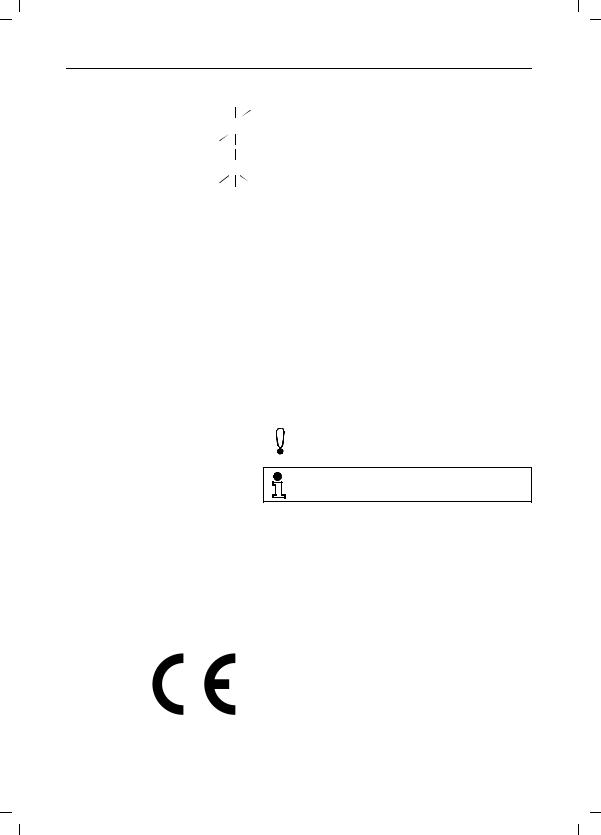
29.10.99 |
kap00.fm5 |
Gigaset 2015 plus, GBR: A30852-X1105-B401-1-7619 |
LED display at the base station
h On/off key flashes: new messages are waiting.
|
Indicates the number of messages stored in the |
05 |
answering machine. |
If there are no new messages, the display is blank. |
Overview: symbols used in the operating instructions
B#*5 Press these handset keys in the order shown. The same symbols/characters are indicated on the keys.
Press this base station key. The same symbol is indicated
Í
on the key. Alternatively, the key is described, e.g. “Press
|
green key at base station“. |
|
|
|
Press one of the keys in the range indicated, e.g. a key |
||
1... 6 between 1 and 6. |
|
||
o |
Enter a number, e.g. a telephone number. |
||
|
Where necessary, appropriate displays are provided on |
||
|
the handset: |
|
|
|
: |
|
(Example: speed dialling |
|
|
3 z |
|
|
|
P fN |
number 3 is not assigned) |
|
|
|
|
|
|
|
|
|
|
Attention - important note. Please read |
|
|
|
carefully! |
|
|
|
|
|
Additional information
page VI
(cross-reference to a related topic)
Certification and CE marking
Siemens Gigasetâ 2015 plus was certified according to EU guideline 91/263/EEC (CTR 6, CTR 10). Anyone is permitted to connect this telephone to a telephone jack and use it.
This telephone fulfils the requirements of the following
EU guidelines:
89/336/EEC |
“Electromagnetic compatibility” |
73/23/EEC |
“Electrical resources used within |
|
specific voltage ranges” |
The CE marking confirms the telephone is in compliance with the above-mentioned guidelines (CE 0188 X)
VI
A2

29.10.99 |
kap01.fm5 |
Gigaset 2015 plus, GBR: A30852-X1105-B401-1-7619 |
Safety information
Only use approved nickel-cadmium (NiCd batteries) or nickel-metal-hybrid batteries (NiMH batteries)! ( page 67).
Never use other types of battery or ordinary (non-rechargeable) batteries, since these can cause short-circuits or destruction of the battery shell (dangerous!). The following labels are attached to the battery compartments of the mobile and charger units:
+ |
|
_ |
Only use rechargeable bat- |
|
B |
|
|
teries; polarity as shown! |
|
|
|
|
|
Type as indicated in these |
|
|
|
|
|
|
|
|
|
installation instructions. |
●Do not immerse cells in water; do not throw them into fire.
●Only use battery cells of the same type! (do not insert batteries of different types)
●Do not dispose of old, defective cells in normal household waste.
●Cells become warm during charging. This is normal and not dangerous.
●Do not use other manufacturers’ charger units. The cells could suffer damage.
●Use only the supplied plug-in power unit specified on the underside of the device.
●Make sure you connect the plugs of the base station correctly, otherwise abnormally high voltages may be produced across the charging contacts for brief intervals, e.g. during thunderstorms.
●The handset must not be operated in rooms with explosion hazards.
VII
A3

29.10.99 |
giga2015.IVZ |
Gigaset 2015 plus, GBR: A30852-X1105-B401-1-7619 |
Contents |
|
Putting the equipment into operation - step by step .............................................................. |
1 |
1st step: reading the safety information ........................................................................................ |
1 |
2nd step: checking the contents of the package ........................................................................... |
1 |
3rd step: Connecting the base station ............................................................................................. |
2 |
4th step: inserting the batteries in the handset ............................................................................. |
3 |
5th step: charging the batteries ..................................................................................................... |
3 |
6th step: setting the day of the week and the time ......................................................................... |
4 |
Incoming calls .............................................................................................................................. |
5 |
Displaying telephone numbers ....................................................................................................... |
5 |
Taking a call .................................................................................................................................... |
5 |
External camp-on in an internal call .................................................................................................. |
6 |
Accepting an external call ............................................................................................................... |
6 |
Terminating the call ........................................................................................................................ |
6 |
Switching off the microphone (mute function) ............................................................................... |
6 |
Outgoing calls .............................................................................................................................. |
7 |
Calling an external number ............................................................................................................. |
7 |
Calling back a caller ........................................................................................................................ |
7 |
Suppressing code numbers for redial ............................................................................................ |
8 |
Suppressing display of telephone numbers on called party’s unit ................................................. |
8 |
Dialling with speed dialling numbers .............................................................................................. |
8 |
Number redial ................................................................................................................................... |
9 |
Temporary tone dialling (DTMF) ..................................................................................................... |
9 |
Terminating the call ........................................................................................................................ |
9 |
Internal calls ............................................................................................................................... |
10 |
Calling an internal station ............................................................................................................. |
10 |
Collective call to all handsets from base station .......................................................................... |
10 |
Collective call to all handsets from a handset .............................................................................. |
10 |
Addressing other persons in the room via loudspeaker (voice calling) ......................................... |
11 |
Open listening via base station loudspeaker ................................................................................ |
11 |
Terminating a call internally .......................................................................................................... |
11 |
Internal consultation and call transfer ..................................................................................... |
12 |
Consultation call ........................................................................................................................... |
12 |
Call transfer .................................................................................................................................. |
13 |
Important basic settings ........................................................................................................... |
14 |
Operating states of the handset .................................................................................................. |
14 |
Signalling method ........................................................................................................................... |
16 |
Operation in conjunction with a PBX .............................................................................................. |
17 |
Trunk codes .................................................................................................................................... |
18 |
Changing the system code/PIN .................................................................................................... |
19 |
Basic settings for the answering machine ..................................................................................... |
21 |
Resetting the base station to the default state ............................................................................ |
24 |
Resetting Gigaset 2000S handset to the default state .................................................................. |
25 |
Setting device connection for Gigaset 1000TAE ............................................................................ |
26 |
Individual settings on the base station ................................................................................... |
27 |
Switching off base station tone ringing or setting volume of tone ringing ................................... |
27 |
Setting pitch of base station tone ringing ..................................................................................... |
27 |
Activating/deactivating key click at base station .......................................................................... |
28 |
Activating/deactivating music-on-hold .......................................................................................... |
28 |
Individual settings on the Gigaset 2000S handset ................................................................. |
29 |
Setting volume of tone ringing ..................................................................................................... |
29 |
Setting pitch of tone ringing ......................................................................................................... |
29 |
VIII |
|

29.10.99 |
giga2015.IVZ |
Gigaset 2015 plus, GBR: A30852-X1105-B401-1-7619 |
|
Contents |
Setting the handset volume ......................................................................................................... |
30 |
Activating/deactivating advisory and warning tones ..................................................................... |
30 |
Activating/deactivating automatic call acceptance ....................................................................... |
32 |
Speed dialling numbers ................................................................................................................ |
32 |
Displaying call duration ............................................................................................................. |
35 |
Activating/deactivating call duration display ................................................................................. |
35 |
Barring functions on the Gigaset 2015 plus ............................................................................ |
36 |
Activating/deactivating if Gigaset 2015 plus barred on outgoing calls ......................................... |
36 |
Emergency numbers if Gigaset 2015 plus is barred .................................................................... |
36 |
Activating/deactivating barred code function ............................................................................... |
39 |
Setting direct trunk access for the handset ................................................................................... |
40 |
Handset barring functions ........................................................................................................ |
41 |
Activating/deactivating handset barring function for outgoing calls ............................................. |
41 |
Displays on handset with active barring function ........................................................................... |
42 |
The answering machine ............................................................................................................ |
43 |
Switching answering machine on/off ........................................................................................... |
43 |
Operating modes ......................................................................................................................... |
44 |
Announcements and advisory message ........................................................................................ |
45 |
Recording conversations ................................................................................................................ |
47 |
Private memos ............................................................................................................................... |
48 |
Messages ..................................................................................................................................... |
48 |
Monitoring function and call acceptance ........................................................................................ |
51 |
Remote operation of the answering machine .............................................................................. |
51 |
Initiating remote operation ............................................................................................................. |
52 |
Remote operation functions ........................................................................................................... |
53 |
Logging on additional handsets at the base station .............................................................. |
57 |
Logging on Gigaset 2000S/1000S handset at the base station .................................................... |
57 |
Logging off handset at base station ............................................................................................. |
58 |
Operating several handsets ...................................................................................................... |
59 |
Assignment of ringing (incoming calls) ......................................................................................... |
59 |
Operation with several base stations ...................................................................................... |
61 |
Activating/deactivating base station number display on handset ................................................. |
61 |
Setting a priority station ................................................................................................................. |
62 |
Operating with Gigaset 2000C, 2000C pocket, 2000T ............................................................ |
63 |
Logging on comfort device at the base station .............................................................................. |
65 |
Remote operation of the answering machine via the comfort device ......................................... |
65 |
Important informations ............................................................................................................. |
66 |
Notes on setting up the base station ........................................................................................... |
66 |
Notes on operating the handset ..................................................................................................... |
67 |
Care of the equipment ................................................................................................................. |
69 |
Technical data ................................................................................................................................ |
70 |
Transfer/disposal .......................................................................................................................... |
71 |
Warranty ....................................................................................................................................... |
71 |
Self-help in the event of a fault ...................................................................................................... |
72 |
Special accessories .................................................................................................................... |
74 |
Quick-reference guide for Gigaset 2000S handset ................................................................. |
75 |
Index ............................................................................................................................................ |
76 |
IX

29.10.99 |
kap02.fm5 |
Gigaset 2015 plus, GBR: A30852-X-1105-B301-1-7619 |
Putting the equipment into operation - step by step
Putting the equipment into operation - step by step
Follow the installation and setup instructions “step by step” as described in the following:
1st step: reading the safety information
Before starting, make sure you have studied the safety information carefully!
2nd step: checking the contents of the package
When delivered, the package contains the following:
●one Gigaset 2015 plus base station (see also label with CE sign on lower part of base station)
●one Gigaset 2000S standard handset (see also marking on rear of handset),
●one telephone connecting cable with Mini-Western plug and telephone plug
●one power connecting cable with Mini-Western plug and power supply unit,
●one cover for battery compartment of handset
●one carrying clip for handset
●two batteries
●one set of operating instructions
1
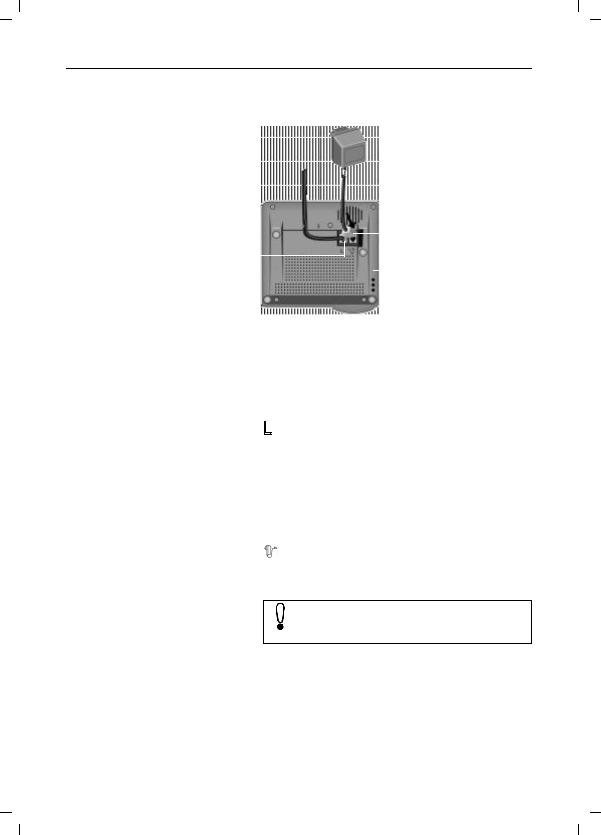
29.10.99 |
kap02.fm5 |
Gigaset 2015 plus, GBR: A30852-X-1105-B301-1-7619 |
Putting the equipment into operation - step by step
3rd step: Connecting the base station
|
|
|
|
|
|
|
|
|
Power supply unit and |
Telephone connecting |
|
|
|
|
|
|
|
220/230V socket |
|
|
|
|
|
|
|
|
|||
|
|
|
|
|
|
|
Power connecting cable |
||
cable |
|
|
|
||||||
|
|
|
|
|
|
|
|
|
Mini-Western plug of |
|
|
|
|
|
|
|
|
|
power connecting cable |
|
|
|
|
|
|
|
|
|
|
Mini-Western plug of |
|
|
|
|
|||||
telephone connecting cable |
|
|
|
|
|
Base station housing |
|||
|
|
|
|
|
|
|
|
|
|
|
|
|
|
|
|
|
|
|
seen from below |
Telephone connecting cable
Insert the Mini-Western plug of the telephone connecting cable in the base station. The jack on the lower part of the base station housing has the following symbol:
Connect the telephone plug of the telephone connecting cable to the telephone socket.
Power connecting cable
Insert the Mini-Western plug of the power connecting cable in the base station. The jack on the lower part of the base station housing has the following symbol:
Connect the power supply unit of the power connecting cable to a 220/230V socket.
For safety reasons, the telephone must only be operated with the plug-in power supply unit supplied.
2
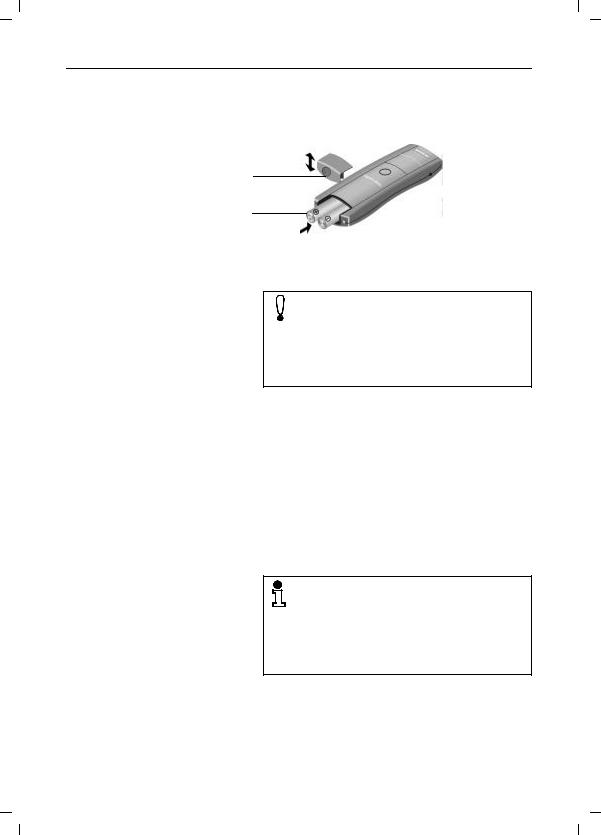
29.10.99 |
kap02.fm5 |
Gigaset 2015 plus, GBR: A30852-X-1105-B301-1-7619 |
Putting the equipment into operation - step by step
4th step: inserting the batteries in the handset
The handset is powered by two batteries.
.
Cover of battery compartment
Battery compartment and batteries
Hold the handset with the keypad downwards.
Insert the batteries in the battery compartment.
Make sure that the batteries have the correct +/– polarity. The +/– markings on the batteries must correspond to the +/– markings on the label in the battery compartment.
If the batteries are aligned wrongly, the handset will not function and the equipment is liable to be damaged.
Slide the cover for the battery compartment into the groove on the handset and close the compartment.
5th step: charging the batteries
To charge the batteries, place the handset in the handset rest on the base station. The charging contacts on the lower edge of the handset must touch the contacts in the handset rest on the base station. It is immaterial whether the keypad is facing up or down.
If you have inserted the handset correctly, an acknowledgement tone is heard. The LED below the battery symbol lights up on the base station.
The batteries must be charged before you can start making calls or settings.
We recommend initially charging the batteries for approximately 16 hours without interruption (over night, for example).
For further information on the use of the batteries see page 67.
3

29.10.99 |
kap02.fm5 |
Gigaset 2015 plus, GBR: A30852-X-1105-B301-1-7619 |
Putting the equipment into operation - step by step
6th step: setting the day of the week and the time
B#I99
1 to 7
0000
to
2359
B
Each new message is annotated with the day and the time at which it arrived (time stamp function of the answering machine).
When the base station is connected up to the power supply or power failure, you will hear the message: “Time setting not available” when you switch on the answering machine.
You will be guided through the procedure for setting the time by means of announcements over the loudspeaker at the base station.
Start the procedure.
The following is output as a check: “Time setting“. You are then prompted to enter the current day.
Enter digit for the week:
1 = Monday, 2 = Tuesday, 3 = Wednesday,
4 = Thursday, 5 = Friday, 6 = Saturday, 7 = Sunday. You are then prompted to enter the current time.
Enter the time using four digits, e.g. 0937 for 9.37 hours.
Store settings.
4
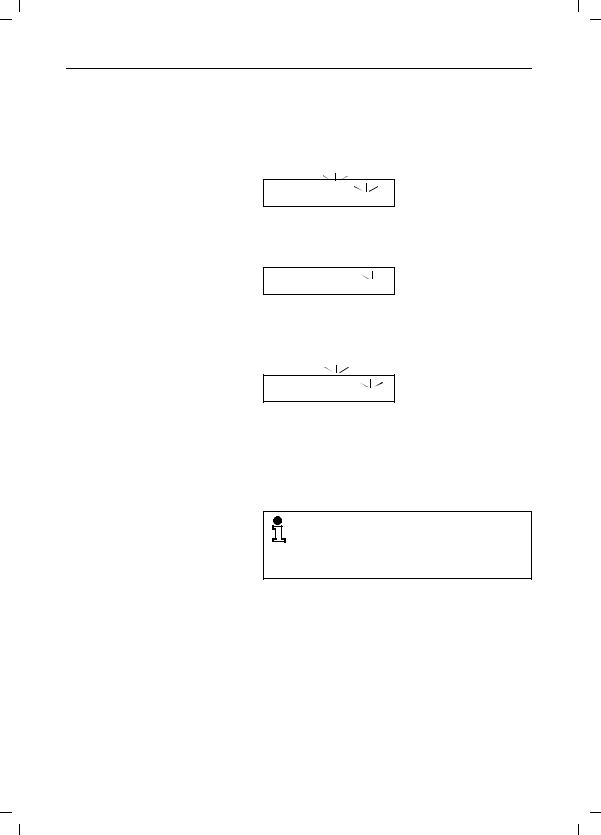
29.10.99 |
kap03.fm5 |
Gigaset 2015 plus, GBR: A30852-X-1105-B301-1-7619 |
Incoming calls
Incoming calls
Displaying telephone numbers
A call is signalled by means of tone ringing.
:
- - - 
f N F
If the carrier supports calling line identification presentation (CLIP), the telephone number of the external caller appears on the display of your handset:
08972244667
f N F
Internal calls can be made if more than one handsets are being operated. You can recognise an internal call by the
following display (a call from station 2 in the following example):
2
f N G
Taking a call
1.If the handset is in the base station or charging unit:
Remove the handset from the charging unit. You are connected.
Automatic call acceptance after removing the handset from the charging unit can also be deactivated ( page 32). If this function has
been deactivated, you must press c when you remove the handset from the charging unit.
2.If the handset is not in the base station or charging unit:
Press the key on the handset (“off-hook”). You are con- c nected.
5

29.10.99 |
kap03.fm5 |
Gigaset 2015 plus, GBR: A30852-X-1105-B301-1-7619 |
Incoming calls
External camp-on in an internal call
If, during an internal call, an incoming external call is signalled by means of a “camp-on signal”, the internal caller can be disconnected and the external call accepted in the usual way.
You are engaged in an internal call. An external call is sig-
cnalled by means of the “camp-on” tone and “EXT” appears in the display.
Accept the external call immediately.
BR or
Disconnect the internal call. You then hear the ringing a tone.
Press the off-hook key and accept the external call.
c
Accepting an external call
Another handset is ringing (e.g. in the case of direct dial- ling-in). You can accept the incoming external call for that unit.
Press the key on the handset or remove the unit from the c charging unit.
The connection is set up.
BR
Terminating the call
Replace the handset in the base station or the charging unit. The call is disconnected.
or
Disconnect the call (“hang up”).
a
If the handset was in protect mode, it will remain in this mode after you press a.
Switching off the microphone (mute function)
When conducting a call with an external party, you can switch off the microphone to consult with somebody else in the room, for example. The external caller is put on hold and cannot listen in. Music is played for the caller on hold.
Press the key on the handset. The microphone is
I switched off. Consult somebody in the room.
Switch on the microphone. You are reconnected with the
R *) Die grünen Symbole D, Fund H auf den Tasten dienen zum externalbesserencallerAuffinden. bzw. Wiedererkennen von Funktionen
und werden bei Aufruf auch im Diplay angezeigt.
6
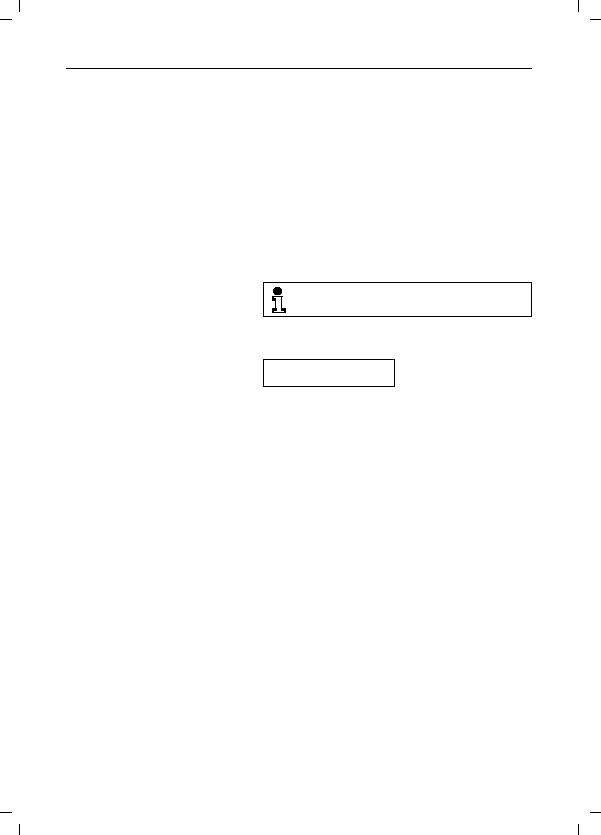
29.10.99 |
kap04.fm5 |
Gigaset 2015 plus, GBR: A30852-X-1105-B301-1-7619 |
Outgoing calls
Outgoing calls
Calling an external number
Press this key (“off-hook”). You hear dial tone.
c
Enter the required number on the keypad of the handset.
o
Dialling with number check
o
Q
c
or
a
You can then check this number on the display.
You can enter the number and then check it before setting up the connection.
The number can consist of a maximum of 22 digits.
Enter the required number on the keypad of the mobile unit. You can then check this number on the display, e.g.:
:
123456
f N
If nessesary, press speed dial key to delete last digit.
Press the key within 30 seconds to seize the dialup line. The number is dialled after a brief interval. Ringing tone is then audible.
If the number has been entered incorrectly, press this key. The input is cancelled. Enter the number again.
Calling back a caller
While you are listening to a message from your handset the caller’s telephone number appears in the display. While the message is being played, press the 4key to make a call to the sender of the message (for further information page 53).
7

29.10.99 |
kap04.fm5 |
Gigaset 2015 plus, GBR: A30852-X-1105-B301-1-7619 |
Outgoing calls
Suppressing code numbers for redial
When you dial a telephone number it is incorporated into the redial list. Both the number dialled after this number, e.g. an extension number and a subsequent secret “service number” is added to the telephone numbers in the redial list. To prevent the incorporation of secret numbers, activate “temporary tone dialling” – e.g. after the extension number ( page 53) even if your telephone is set to tone dialling.
Suppressing display of telephone numbers on called party’s unit
To suppress display of your telephone number on the called party’s unit, use a sequence of telephone services (CLIR). To do this, your telephone must be set to tone dialling (DTMF).
Press the off-hook key.
c
Enter Service sequence for telephone number suppres- *31# sion, wait for dial tone and then
dial the telephone number.
o
A prerequisite here is that the network provider must support this function.
Dialling with speed dialling numbers
|
If you have programmed speed dialling numbers |
|
( page 32), you can dial the associated number by enter- |
|
ing a speed dialling number. |
c Seize the dialup line. You hear dial tone. |
|
Qo |
Press the speed dialling key and enter the speed dialling |
code (0 to 9) for the required number. |
|
or
If you are not sure of the speed dialling code for the
Qrequired number: keep pressing the speed dialling key until both numbers appear on the display.
oEnter the speed dialling code displayed (4 in this example).
8

29.10.99 |
kap04.fm5 |
Gigaset 2015 plus, GBR: A30852-X-1105-B301-1-7619 |
Outgoing calls
Number redial
Redialling the last number called
Redialling one of the last five numbers called
c You hear dial tone.
OThe last number called is redialled. You then hear ring tone.
OPress this key unit the required call number appears on the handset’s display.
You can delete part or all of the selected call number with
Qthe speed dial key in order to make corrections where applicable,
c The call number is dialled. You then hear the ring tone.
Temporary tone dialling (DTMF)
Precondition: an external connection has been set up.
Press the keys in turn. The signalling method is switched
B*
to DTMF for the duration of the call. DTMF is indicated by the symbol Fon the display of the handset.*)
Terminating the call
Replace the handset in the base station or charger unit.
The connection is cleared down.
or
Clear down the connection.
a
*) The green symbols D, Fand H on the keys make it easier to find or recognise the functions.
9

29.10.99 |
kap05.fm5 |
Gigaset 2015 plus, GBR: A30852-X-1105-B301-1-7619 |
Internal calls
Internal calls
Calling an internal station
|
If there are several handsets ( page 59), you can make |
|||
|
internal calls to the other handsets. These calls are free of |
|||
|
charge. |
|
|
|
Io |
Press the internal key on your own handset and enter the |
|||
number of the required unit (1 to 6). You hear internal |
||||
|
ringing tone. The handset is called. |
|
|
|
Checking your own internal number |
|
|
|
|
|
Press the internal key to |
|
|
|
|
|
|
|
|
I display the internal tele- |
f N b |
1 |
|
|
|
phone number of the |
G |
|
|
|
|
|
|
|
handset.
Collective call to all handsets from base station
A collective call from the base station can be used, for example, to trace handsets which have been relocated. You cannot make internal calls during a collective call from the base station.
A collective call from the base station can be made even if there is only one handset.
Press the green paging key at the base station. All
?accessible handsets are called for approximately 30 seconds.
Terminating call prematurely
Press the green paging key at the base station.
?
or
Clear down the connection at the handset.
c
Collective call to all handsets from a handset
If there are several handsets, you can make a multiaddress call from any handset to all other (accessible) handsets. The first internal user to take the call is then connected to you. You can also use this function to search for handsets that have relocated.
Press the keys in turn. You hear internal ringing tone.
I*
All accessible handsets and supplementary devices are called.
10

29.10.99 |
kap05.fm5 |
Gigaset 2015 plus, GBR: A30852-X-1105-B301-1-7619 |
Internal calls
Addressing other persons in the room via loudspeaker (voice calling)
You can speak directly to other persons in the room by way of the base station loudspeaker.
Press the keys on the handset to call the answering ma-
I9
chine. A preparatory tone, the mode of operation, the current number of saved messages as well as the day of the week are output.
There is an advisory announcement: “Voice calling“.
69
A preparatory tone is then applied. Speak via the loudspeaker.
Open listening via base station loudspeaker
You can switch over to open listening during a call to an external subscriber. The subscriber can then be heard via the base station’s loudspeaker. This enables other persons in the room to listen in on the call.
Precondition: an external connection has been set up.
Activating/deactivating open listening.
I8
The volume of the loudspeaker can be regulated at the base station with keys +and-.
Open listening is also possible during recording of a call ( page 48).
Terminating a call internally
Replace the handset in the base station or charger unit.
The connection is cleared down.
or
Clear down the connection.
a
11

29.10.99 |
kap06.fm5 |
Gigaset 2015 plus, GBR: A30852-X-1105-B301-1-7619 |
Internal consultation and call transfer
Internal consultation and call transfer
During an external call you can
● switch off the microphone and consult with another person in the room,
● transfer the outside call to an internal station user.
Consultation hold and call transfer are only possible
● if several handsets are in operation ( page 59)
Consultation call
Operation with several handsets |
|
|
If a number of handsets are in operation ( page 59), you |
|
can consult with an internal user in the course of an exter- |
|
nal call. The external subscriber is placed on hold |
|
and cannot listen in (instead, he receives music on hold). |
Io |
Press the internal key and then enter the number of the |
required handset (1 to 6). You hear internal ringing tone. |
|
|
The handset is called. The external call is held. |
|
Terminating consultation/continuing external call |
RTerminate internal consultation. You are reconnected to the external subscriber.
Operation in connection with a PBX
During an external call you can consult with another station user connected to your telecommunications system (PBX). In such cases note carefully the operating instructions for the telecommunications system
RInitiate consultation. You hear dial tone. The external call is held.
oEnter the number of the required station. The user is called.
Terminating consultation/continuing external call
RTerminate internal consultation. You are reconnected to the external subscriber.
12

29.10.99 |
kap06.fm5 |
Gigaset 2015 plus, GBR: A30852-X-1105-B301-1-7619 |
Internal consultation and call transfer
Call transfer
Operation with several handsets |
|
|
|
|
|
|
If a number of handsets are in operation ( page 59), you |
||||
|
can transfer an external call to an internal station user. |
||||
Io |
Press the internal key and then enter the number of the |
||||
required handset (1 to 6). You hear internal ringing tone. |
|||||
|
The handset is called. The external call is held. |
||||
either |
|
|
|
|
|
|
Wait until the internal party answers. Inform this user |
||||
|
about the outside call. |
||||
a |
Transfer the external call. |
||||
|
|
|
|
|
|
or |
|
|
|
|
|
|
Instead of waiting until the called party answers, transfer |
||||
a the call directly. |
|||||
|
|
|
|
|
|
|
|
|
|
|
Instead of pressing ayou can replace your |
|
|
|
|
|
handset in the charger unit. |
|
|
|
|
|
If you transfer the external call directly and the |
|
|
|
|
|
|
|
|
|
|
|
user fails to take the call within 30 seconds, you |
|
|
|
|
|
are recalled. |
|
|
|
|
|
If you transfer the external call directly and the |
|
|
|
|
|
user is busy, you are recalled immediately. |
|
|
|
|
|
If you take the recall, you are reconnected to the |
|
|
|
|
|
external subscriber. A recall is taken in the same |
|
|
|
|
|
way as any other type of call ( page 5). |
Operation in connection with a PBX |
|
|
|
|
|
|
|
|
|
|
|
|
If your telephone is connected to a telecommunications |
||||
|
system (PBX), you can transfer an external call to an inter- |
||||
|
nal station user. In such cases note carefully the operating |
||||
|
instructions for the telecommunications system. |
||||
|
Initiate consultation. You hear dial tone. The external call |
||||
R is held. |
|||||
o |
Enter the number of the required station. The user is |
||||
|
called. |
||||
|
Wait until the internal party answers. Inform this user |
||||
|
about the outside call. |
||||
a Transfer the external call.
13
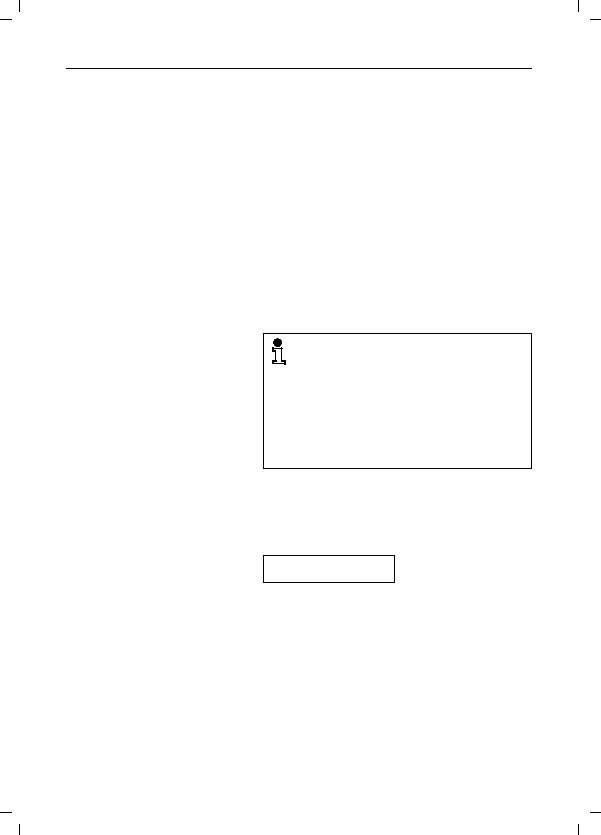
29.10.99 |
kap07.fm5 |
Gigaset 2015 plus, GBR: A30852-X-1105-B301-1-7619 |
Important basic settings
Important basic settings
Operating states of the handset
The handset can be operated in one of three different modes:
●“protect”
●“off”
●“on”
The protect mode ensures that you do not activate the handset keypad unintentionally. The handset is switched on automatically for incoming calls. To make an outgoing call you must first switch on the handset.
When the unit is switched off, incoming calls are not signalled. To make an outgoing call you must first switch on the handset.
The protect mode should be used if you are carrying the unit in your pocket, for example.
We advise you to switch off the handset if you move out of range of the base station. This helps to preserve the batteries.
If you were out of range of the base station for some time with your handset switched on, you can speed up “relocation” of the base
station by switching the handset off for a brief time and then on again.
Switching handset to protect state
Press the key on the handset briefly. You hear positive
h
acknowledgement tone. If the handset is in the protect state, the display shows:
:
zzzz
fN
14

29.10.99 |
kap07.fm5 |
Gigaset 2015 plus, GBR: A30852-X-1105-B301-1-7619 |
Important basic settings
Switching on the handset
If the handset is in the protect state:
Press the key on the handset briefly. You hear positive
hacknowledgement tone. When the handset is switched on. the display shows:
:
f N
If the handset is switched off:
Press the key on the handset briefly. You hear positive ac-
hknowledgement tone. The symbol Non the display flashes. Wait until the symbol stops flashing. The handset is switched on.
or
Replace the handset in the base station or charger unit. The symbol N appears on the display. The handset is switched on.
Switching off the handset
Press the key on the handset until the display disappears
h
completely. You hear positive acknowledgement tone.
15

29.10.99 |
kap07.fm5 |
Gigaset 2015 plus, GBR: A30852-X-1105-B301-1-7619 |
Important basic settings
Signalling method
Telekom operates telephone connections with two different signalling methods:
●dial pulsing (DP)
●dual-tone multifrequency signalling (DTMF)
The factory default setting of your Gigaset 2015 plus is
DTMF signalling.
However, DTMF is only possible if your telephone is connected to a new digital central office. Since Telekom has not yet completed changeover to digital switching, some telephones still have to be set for dial pulsing.
Checking the signalling method of your telephone line
c |
Press the off-hook key. You will hear dial tone. |
|
Press any digit, e.g. 2. If the same dial tone is audible as |
||
o |
||
previously, you will have to change the signalling method |
||
|
to dial pulsing (DP). |
|
Setting the signalling method |
|
|
B#1 |
Start the procedure. |
|
Enter the 4-digit system code; default “0000” |
||
o |
||
( page 19). |
||
O033B |
Set dial pulsing (DP). |
|
|
||
or |
|
|
O037B |
Set dual-tone multifrequency signalling (DTMF). |
|
|
16

29.10.99 |
kap07.fm5 |
Gigaset 2015 plus, GBR: A30852-X-1105-B301-1-7619 |
Important basic settings
Operation in conjunction with a PBX
To operate your Gigaset 2015 plus in conjunction with a
PBX, you must first enter the following:
1.the signalling method,
2.the trunk or the main trunk code and
3.the length of the pause following the trunk or main trunk code.
Options for setting the signalling method
The signalling method factory setting is
●DTMF/Flash
For operation in conjunction with PBXs, you must first switch to one of the following:
● DP or
● DTMF/Flash
|
When doing this, please read the operating instructions |
|
|
for your PBX. |
|
B#1 |
Start the procedure. |
|
Enter the 4-digit system code (default: “0000”) |
||
o |
||
( page 19). |
||
O033B |
Set dial pulsing (DP). |
|
|
or
Set tone dialling DTMF/Flash.
O037B
17
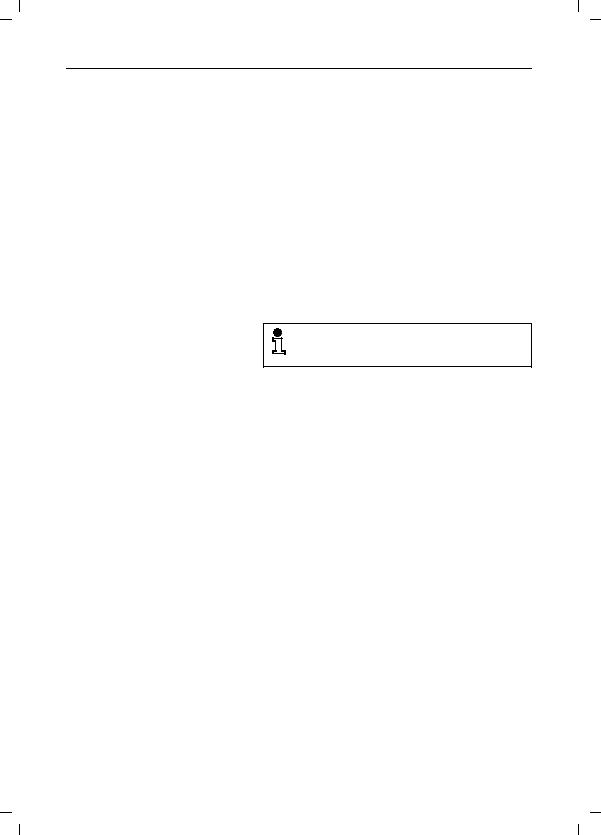
29.10.99 |
kap07.fm5 |
Gigaset 2015 plus, GBR: A30852-X-1105-B301-1-7619 |
Important basic settings
Trunk codes
If you operate your Gigaset 2015 plus in conjunction with a PBX (telecommunications system), you can set the following for switching to the public telephone network:
●the trunk code
●the length of the pause following the trunk code (if a dial pause is required after the trunk code has been entered).
If the PBX is a satellite to a main PBX, you can set the following:
●the trunk code
●the main trunk code
●the length of the pause following the trunk code/main trunk code
For details of the trunk code/main trunk code and the length of pause please refer to the PBX documentation.
Entering trunk code/main trunk code
|
The trunk codes/main trunk codes consist of 1, 2 or 3 dig- |
|
|
its and can consist of digits 0to 9 and keys :, # |
|
B#0 |
and R. |
|
Start the procedure. |
||
Enter the 4-digit system code (default: “0000”) |
||
o |
||
( page 19). |
||
O |
Select the trunk code. |
|
|
||
or |
|
|
OO |
Select the main trunk code. |
|
Enter the trunk code/main trunk code. If there are several |
||
o |
||
codes, you can press O again to enter the next code. |
||
B |
Store the setting. |
|
|
18
